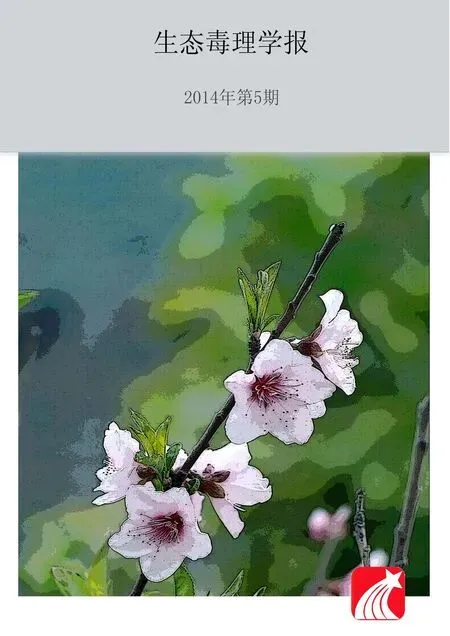九龙江河口潮间带表层沉积物汞污染分布、赋存形态与生态风险
林承奇,于瑞莲,胡恭任,何海星
华侨大学化工学院,厦门 361021
九龙江河口潮间带表层沉积物汞污染分布、赋存形态与生态风险
林承奇,于瑞莲*,胡恭任#,何海星
华侨大学化工学院,厦门 361021
研究九龙江河口汞污染情况可为该地区汞污染防治提供科学依据,测定九龙江河口潮间带表层沉积物中总汞含量及不同形态汞的含量,分析了汞的分布特征、赋存形态及生物有效性和潜在生态风险。结果表明:九龙江河口潮间带表层沉积物中总汞含量范围0.112~0.259 mg·kg-1,平均值0.172 mg·kg-1,部分采样点汞含量超过中国海洋沉积物质量第一类标准限值(0.20 mg·kg-1);沉积物中各形态汞平均比例顺序:残渣态(61.8%)>可氧化态(27.8%)>弱酸溶态(7.8%)>可还原态(2.6%),可提取态占有相当的比例,对水体汞污染具有一定贡献。潜在生态风险指数法评价结果可知,该河口区潮间带沉积物中汞污染程度和生态风险程度均为中等~较高水平,需对汞污染进行综合防治。
汞;形态;生态风险;表层沉积物;九龙江河口
汞是重金属“五毒”之一,具有毒性强、易迁移、高生物蓄积性等特点。自“水俣病”公害事件发生以后,汞的地球化学行为及其环境效应引起了国内外众多学者的关注。近年来,随着经济的快速发展,人类向水体环境排放的汞大量增加[1]。沉积物是汞在水体中的主要分布相[2]。随着环境条件的改变,贮存在沉积物中的汞有可能重新释放而对周围环境造成二次污染[3]。
九龙江河口区位于厦门港西南部,其海端以北为厦门港西海域(是厦门港口、码头区和海水养殖区,也是城市污水排泄区)[4]。近年来,九龙江流域经济发展迅速,造成该河口水体污染问题日渐突出,尤其是河口区的重金属污染状况备受关注[4-8]。目前,国外已有对欧共体标准署提出的三步连续提取法(简称BCR法)进行改进研究沉积物中汞形态的报道[9],国内已有部分学者在评价九龙江河口沉积物中重金属污染时涉及到汞[4-5],但针对该河口沉积物中汞形态的研究尚鲜见报道。本文研究了九龙江河口潮间带表层沉积物中汞的分布及其赋存形态,为评价九龙江河口汞污染现状及制定合理的防治措施提供一定科学依据。
1 材料与方法(Materials and methods)
1.1 样品采集与预处理
采样工作于2012年10月潮水退至最低时进行,共采集20个潮间带表层沉积物样品,具体采样点分布如图1。采样时,用塑料勺采集表层0~5 cm的沉积物,在每个样点的5 m×5 m范围内随机采集3个表层沉积物样,混合均匀作为一个样品;装入干净的可封口塑料袋中密封,注明采样时间、地点和样品编号。将采集到的样品放于装有冰块的保温箱中运回实验室,置于冰箱中-20℃冷冻保存备用。预处理时,将冷冻24 h后的沉积物样品置于干净、通风、阴凉的实验台面上晾干,用干净的木棒捣碎,剔除杂物,用玛瑙研钵轻轻研磨,过63 μm尼龙筛,筛下样装入干净的可封口塑料袋中密封保存备用。
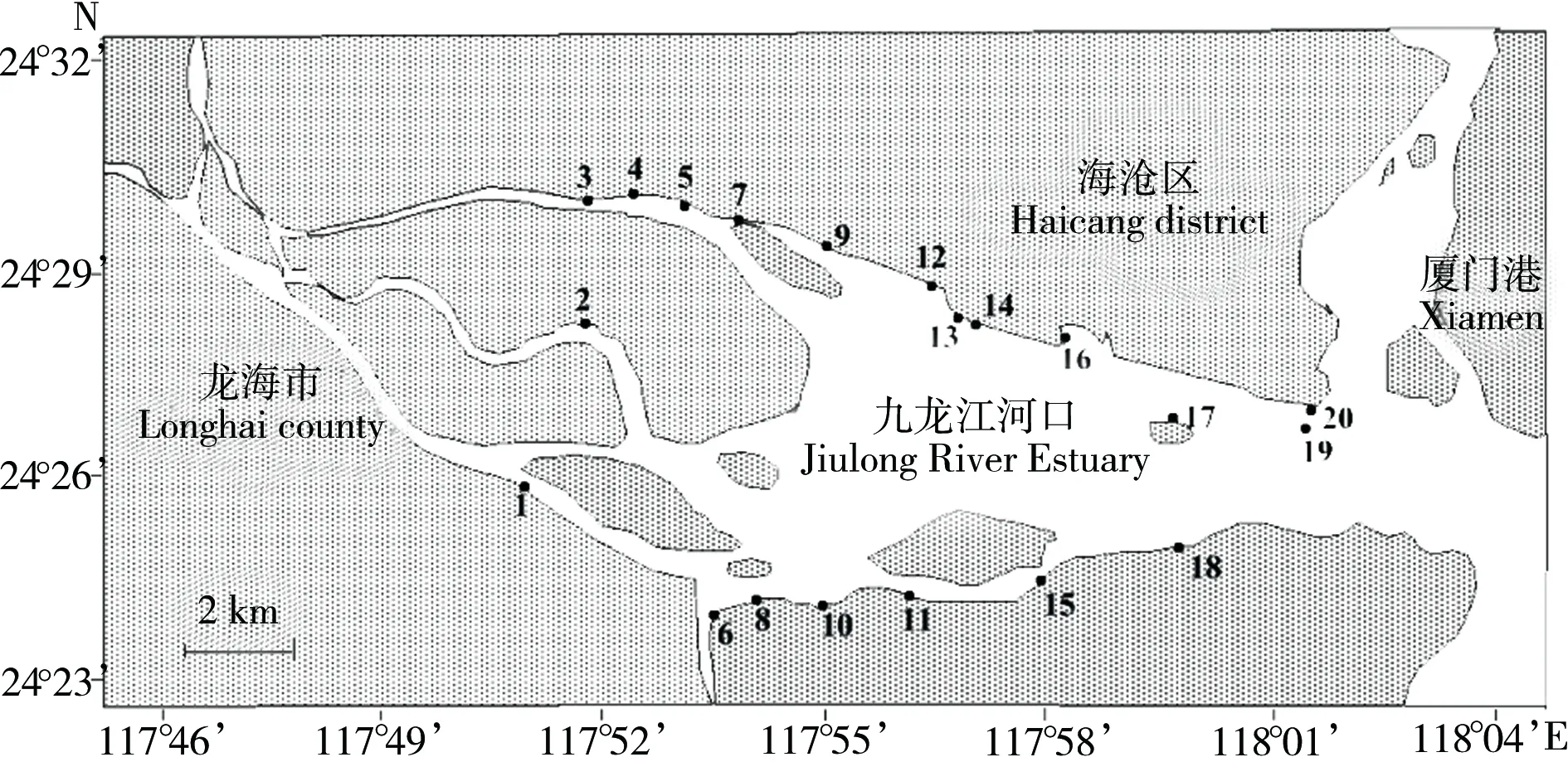
图1 九龙江河口潮间带沉积物采样点分布图Fig. 1 Sampling locations of intertidal sediment in Jiulong River estuary
1.2 样品分析方法
沉积物中的总汞采用王水提取法:称取沉积物样品0.2000 g于50 mL离心管中,加入王水4 mL,加盖、摇匀,置黑暗处放置24 h。然后取出、摇匀,盖子旋松稍开一条缝,放入80±2 ℃水浴中消解2 h,其间摇动1~2次。离心管冷至室温,加入10 mL盐酸(5%)溶液,离心,上清液过滤至50 mL容量瓶中,如此反复离心过滤三次,上清液合并至上述容量瓶中,用盐酸(5%)溶液定容至刻度,摇匀,并做全程空白对照。
沉积物中汞形态采用改进的BCR四步连续提取法[10]:弱酸溶态(F1),即可交换态和碳酸盐结合态;可还原态(F2),即铁、锰氧化物结合态;可氧化态(F3),即有机物和硫化物结合态;残渣态(F4),即与矿物晶格强烈结合态。其中F1为有效态,F2和F3为潜在有效态,有效态和潜在有效态又统称为生物有效态;F4态不可为生物所利用,所以称之为不可利用态[11]。
用瑞利AF-640型原子荧光光谱仪测定以上提取液中总汞及各形态汞的含量(以空白测定的3倍标准偏差为检出限0.009 μg·L-1)。用土壤成分分析标准物质GBW07407进行全程质量控制,总汞测定结果的相对标准偏差<5.0%,相对误差<10.0%;BCR四态总和的回收率(四态和占总量的比例)为85.3%~101.3%。
1.3 总汞生态风险评价方法——潜在生态风险指数法
潜在生态风险指数法(potential ecological risk index)由瑞典科学家Hakanson提出,其计算公式为:
Cf=Cs/Cb;Er=Tr×Cf
(1)
式中:
Cf为沉积物中某重金属元素的污染系数;
Cs为沉积物中该元素的实测含量;
Cb为该元素的背景值,本文采用福建省海岸带土壤环境背景值(Hg为0.063 mg·kg-1)[13];
Er为该元素的潜在生态风险系数;
Tr为该元素的毒性响应系数, 汞的毒性响应系数取40。
沉积物中重金属污染系数和生态风险系数对应的污染程度和潜在生态风险程度见表1。
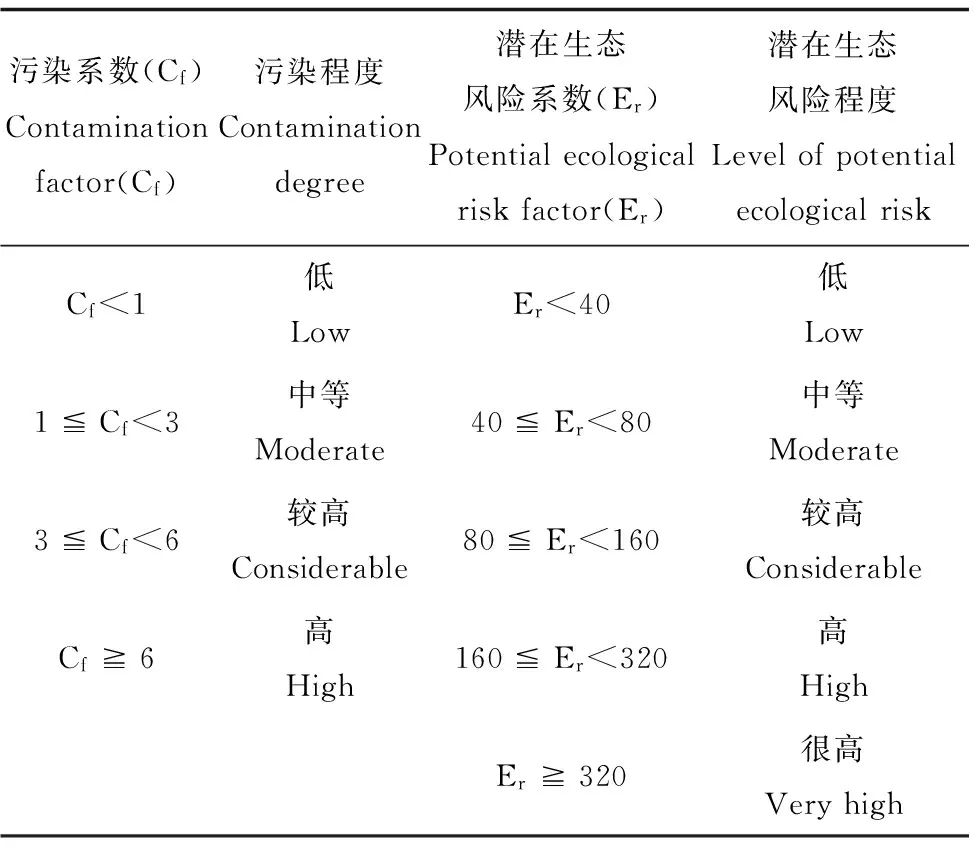
表1 Cf、Er对应的污染程度及潜在生态风险程度分级Table 1 Degrees of contamination and potential ecological risk corresponding to the values of Cf and Er
1.4 数据处理
利用origin 8.5进行数据处理和分析作图。
2 结 果(Results)
2.1 九龙江河口潮间带表层沉积物中汞含量及其赋存形态
九龙江河口潮间带表层沉积物中生物有效态汞与总汞的比较见图2,各形态汞所占比例见图3。由图2可见,采样点6#、9#、13#、15#处的总汞含量分别为0.234、0.236、0.220、0.259 mg·kg-1,超过中国海洋沉积物质量(GB18668-2002)第一类标准限值(0.20 mg·kg-1),但符合第二类标准限值(0.50 mg·kg-1),其余采样点及研究区平均值(0.172 mg·kg-1)符合第一类标准限值。除少数采样点(8#、11#、12#、17#和18#)外,沉积物中生物有效态汞含量占有相当的比例(27.6%~78.5%)。
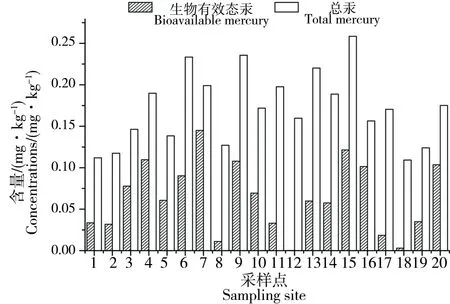
图2 表层沉积物中汞的生物有效态与总量Fig. 2 Bioavailable and total mercury in the surface sediments

图3 表层沉积物中汞形态分布Fig. 3 Speciation distribution of mercury in the surface sediments
从图3中可知,九龙江河口潮间带表层沉积物中的汞主要以残渣态存在(平均比例61.8%),其次是可氧化态(平均比例27.8%),少量的弱酸溶态(平均比例7.8%)和可还原态(平均比例2.6%)。采样点6#、7#、10#、11#、13#、14#和15#处的弱酸溶态所占比例相对较高,分别为10.7%、21.7%、18.5%、11.2%、9.8%、11.7%和32.3%。
2.2 九龙江河口潮间带表层沉积物中总汞的污染系数和潜在生态风险系数
据式(1),九龙江河口潮间带表层沉积物中Hg的污染系数(Cf)和潜在生态风险系数(Er)结果见图4。从图4中可知,采样点4#、6#、7#、9#、11#、13#、14#和15#处的汞为较高污染程度,其余采样点处的汞为中等污染程度;采样点1#、2#、18#和19#处的汞为中等潜在生态风险水平,采样点15#处的汞为高潜在生态风险水平,其余采样点处的汞均为较高潜在生态风险水平。
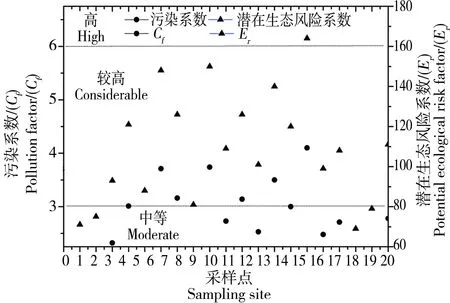
图4 表层沉积物中总汞的污染系数(Cf)和潜在生态风险系数(Er)Fig. 4 Pollution factor (Cf) and potential ecological risk factor (Er) of total mercury in the surface sediments
3 讨 论(Discussion)
3.1 九龙江河口潮间带表层沉积物中总汞污染分布
从图2可知,九龙江河口区潮间带已有部分采样点(6#、9#、13#、15#)总汞含量超过海洋沉积物质量第一类标准限值(0.20 mg·kg-1)。孙阳昭等[14]研究表明,中国汞污染主要来源于燃煤和冶炼行业、电石法-PVC生产行业以及含汞器具的使用等。结合九龙江河口周围具体调查发现,采样点6#位于一条支流的入河口,该支流途经白水镇、浮宫镇等,受人类排污影响较大,主要污水源为生活污水,支流携带的污染物在入河口沉积造成该处汞含量偏高;采样点9#和13#位于角美镇南部,附近有港龙汽车工业园、五金塑胶工业公司等多家工业企业,且在采样点附近发现有排污口,污水可能来源于工业排放,因此汞含量较高;采样点15#位于龙海市田墘,近年来,九龙江河口南部港尾镇大部分水田开发成水产养殖、旱地开发成园地,农民为追求高产投放过量的化肥、农药以及水产养殖投放的激素、药物等都会对九龙江河口造成污染。另外,位于海沧区的SY火电厂和位于九龙江入海口南部的后石火电厂采用海水脱硫技术产生的废水也是汞污染的主要来源之一。九龙江是龙岩、漳州、厦门沿岸各城乡工农业和生活饮用水水源,源头水质应执行国家标准《地表水环境质量标准》(GB3838-2002)Ⅰ类水质标准,河口水质应执行Ⅲ类水质标准,根据黄海宁等[15]研究表明,2009年夏季九龙江河口表层水中汞含量范围0.010~0.038 μg·L-1,超过了上述标准Ⅴ类水质汞含量限值(0.001 μg·L-1),综合分析沉积物以及水体中汞含量可知,九龙江河口已受到一定程度的汞污染。不同年代九龙江河口沉积物中汞含量对比见表2,可见,近年来九龙江河口区汞污染呈加重趋势。梁英[16]报道的九龙江流域对照点沉积物中总汞含量(0.017 mg·kg-1)小于福建省海岸带土壤环境背景值,说明九龙江河口区的汞污染是受人类活动的影响。

表2 不同年代九龙江河口表层沉积物汞含量Table 2 Mercury content in the surface sediments of Jiulong River estuary at different year
为进一步了解九龙江河口区潮间带汞污染水平,表3中列出了国内外某些河口区沉积物中的汞含量。从表3中可知,九龙江河口区表层沉积物中汞含量比国内外一些河口区高,美国环保部建议沿海沉积物中汞的效应范围下限和影响范围中值分别为0.150 mg·kg-1和0.750 mg·kg-1,九龙江河口潮间带部分表层沉积物汞含量在两值之间,进一步说明了九龙江河口已受到一定程度的汞污染。
3.2 九龙江河口潮间带表层沉积物中汞的生物有效性分析及生态风险评价
从图2可知,除少数采样点(8#、11#、12#、17#和18#)外,研究区沉积物中生物有效态汞占总汞比例(27.6%~78.5%)远高于印度戈达瓦里河口沉积物中有效态汞比例(1.5%~7.2%)[9],可推测本研究区沉积物中的汞对水体汞污染的贡献不可忽视。从图3可知,本研究中生物有效态的汞主要是可氧化态即有机结合态的汞,它可以转化为小分子的汞,从而被水生生物利用进入食物链,造成整个生态系统的汞危害[22]。
由图4可知,60%采样点沉积物中的汞为中等污染程度,其余40%采样点处的汞为较高污染程度;20%采样点处的汞为中等潜在生态风险水平,其余80%采样点处的汞为较高或高潜在生态风险水平。可见,九龙江河口区潮间带沉积物已受到一定程度的汞污染,且具有较高的潜在生态风险。将生态风险系数Er与生物有效态汞含量(非残渣态含量)及生物有效态汞所占比例进行相关性分析,结果见表4。从表4可知,生态风险系数与生物有效态汞含量显著相关,说明沉积物中生物有效态汞含量越高,汞生态风险越高,这与刘俊华等[22]阐述的生物有效汞可被生物利用进而影响生态系统相一致。结合前文讨论可知,随着城市化和工业化的推进,九龙江河口区的汞污染正在加重,应加强对该区域汞污染的综合防治。

表3 不同河口区表层沉积物中汞含量对比Table 3 Comparison of mercury content in surface sediments at different estuaries

表4 相关性分析Table 4 Correlation analysis
注:样本数N=20,**: 在 0.01 水平(双侧)上显著相关。
Note: Number of samples N=20,**: Significant correlation at the 0.01 level (bilateral).
[1] Carbonaro R F, Mahony J D, Walter A, et al. Experimental and modeling investigation of metal release from metal-spiked sediment [J]. Environmental Toxicology and Chemistry, 2005, 24: 3007-3019
[2] 锺寰, 王文雄. 沉积物中汞的生物可利用性研究进展[J]. 环境化学, 2011, 30(1): 165-178
Zhong H, Wang W X. Bioavailability of mercury in sediments: A review [J]. Environmental Chemistry, 2011, 30(1): 165-178 (in Chinese)
[3] 王继纲, 陈金民. 厦门港湾潮间带沉积物中汞的赋存形态及其释放动力学[J]. 台湾海峡, 2011, 30(3): 310-315
Wang J G, Chen J M. Release kinetics and speciation of mercury in the intertidal sediments of Xiamen Harbor [J]. Journal of Oceanography in Taiwan Strait, 2011, 30(3): 310-315 (in Chinese)
[4] 王伟力, 耿安朝, 刘花台, 等. 九龙江口表层沉积物重金属分布及潜在生态风险评价[J]. 海洋科学进展, 2009, 27(4): 502-508
Wang W L, Geng A C, Liu H T, et al. Distribution and potential ecological risk evaluation of heavy metals in the surface sediments from the Jiulongjiang River Estuary [J]. Advances in Marine Science, 2009, 27(4): 502-508 (in Chinese)
[5] 于瑞莲, 余伟河, 胡恭任, 等. 九龙江河口上游表层沉积物中重金属赋存形态及生态风险[J]. 环境化学, 2013, 32(012): 2321-2328
Yu R L, Yu W H, Hu G R, et al. Speciation and potential ecological risk of heavy metals in the surface sediments from upstream of Jiulong river estuary [J]. Environmental Chemistry, 2013, 32(12): 2321-2328 (in Chinese)
[6] 和转, 胡毅, 陈坚. 九龙江河口区表层沉积物重金属元素分布特征及其沉积环境[J]. 台湾海峡, 2009, 28(4): 455-459
He Z, Hu Y, Chen J. Heavy metal distribution in surface sediment and sedimentary environment in Jiulongjiang Estuary [J]. Journal of Oceanography in Taiwan Strait, 2009, 28(4):455-459 (in Chinese)
[7] 林彩, 林辉, 陈金民, 等. 九龙江河口沉积物重金属污染评价[J]. 海洋科学, 2011, 35(8): 11-17
Lin C, Lin H, Chen J M, et al. Pollution assessment of heavy metals in the sediment of Jiulong River Estuary [J]. Marine Sciences, 2011, 35(8): 11-17 (in Chinese)
[8] 柳浩然,雷怀彦,王蒙光,等. 九龙江河口湾表层沉积物中重金属分布及其潜在生态风险[J]. 厦门大学学报(自然科学版), 2009, 48(3): 456-460
Liu H R, Lei H Y, Wang M G, et al. Distribution and ecological risk assessment of heavy metals in sediments of Jiulong river estuary [J]. Journal of Xiamen University (Natural Science), 2009, 48(3): 456-460 (in Chinese)
[9] Chakraborty P, Raghunadh Babu P V, Vudamala K, et al. Mercury speciation in coastal sediments from the central east coast of India by modified BCR method [J]. Marine pollution bulletin, 2014, 81(1): 282-288
[10] Yu R L, Hu G R, Wang L J. Speciation and ecological risk of heavy metals in intertidal sediments of Quanzhou Bay, China [J]. Environmental monitoring and assessment, 2010, 163(1-4): 241-252
[11] Adamo P, Arienzo M, Imperato M, et al. Distribution and partition of heavy metals in surface and sub-surface sediments of Naples city port [J]. Chemosphere, 2005, 61(6):800-809
[12] Lars Hakanson. An ecological risk index for aquatic pollution control. A sedimentological approach [J]. Water research, 1980, 14(8):975-986
[13] 刘用清. 福建省海岸带土壤环境背景值研究及其应用[J]. 海洋环境科学, 1995, 14(2): 68-73
Liu Y Q. Study and application of the soil environmental background values in Fujian coastal zone [J]. Marine Environmental Science, 1995, 14(2): 68-73 (in Chinese)
[14] 孙阳昭, 陈扬, 蓝虹, 等. 中国汞污染的来源, 成因及控制技术路径分析[J]. 环境化学, 2013, 32(6): 937-942
Sun Y Z, Chen Y, Lan H, et al. Study on pollution sources,cause of mercury pollution and its control technical roadmap in China [J]. Environmental Chemistry, 2013, 32(6): 937-942 (in Chinese)
[15] 黄海宁, 林彩, 孙秀武, 等. 2009年夏季九龙江口表层水主要化学要素的含量分布和来源分析[J]. 台湾海峡, 2012, 31(2): 261-267
Huang H N, Lin C, Sun X W, et al. Analysis of concentration distribution and source of main chemical elements in the surface water of Jiulongjiang Estuary during 2009 summer [J]. Journal of Oceanography in Taiwan Strait, 2012, 31(2): 261-267 (in Chinese)
[16] 梁 英. 厦门市城市土壤与尘土、SY电厂海域及九龙江河口红树林区汞的形态分布特征[D]. 厦门: 厦门大学, 2009
Liang Y. Distribution of mercury in the soil,dist,marine sediment near SY coal-power plant and Jiulong River mangrove ecosystem in Xiamen City [D]. Xiamen: Xiamen University, 2009 (in Chinese)
[17] 李桂海,蓝东兆,曹志敏,等. 厦门海域沉积物中的重金属及其潜在生态风险[J]. 海洋通报, 2007, 26(1): 67-72
Li G H, Lan D Z, Cao Z M, et al. Specificity and potential ecological risks of heavy metals in the Sediments of the Xiamen Sea Area [J]. Journal of Marine Science Bulletin, 2007, 26(1): 67-72 (in Chinese)
[18] 胡恭任, 于瑞莲, 陈丽萍, 等. 泉州湾洛阳江潮间带表层沉积物重金属污染评价[J]. 矿物岩石, 2011, 31(1): 109-115
Hu G R, Yu R L, Chen L P, et al. Evaluation of pollution of heavy metal in Luoyangjiang intertidal sediments,Quanzhou Bay [J]. Journal of Mineralogy and Petrology, 2011, 31(1): 109-115 (in Chinese)
[19] 李磊, 平仙隐, 王云龙, 等. 长江口及邻近海域沉积物中重金属研究——时空分布及污染分析[J]. 中国环境科学, 2012, 32(12): 2245-2252
Li L, Ping X Y, Wang Y L, et al. Spatial and temporal distribution and pollution analysis of the heavy metals in surface sediments of the Changjiang Estuary and its adjacent areas [J]. China Environmental Science, 2012, 32(12): 2245-2252 (in Chinese)
[20] Abi-Ghanem C, Nakhle K, Khalaf G, et al. Mercury distribution and methylmercury mobility in the sediments of three sites on the Lebanese coast, eastern Mediterranean [J]. Archives of Environment Contamination and Toxicology, 2011, 60: 394-405
[21] Apeti D A, Lauenstein G G, Evans D W. Recent status of total mercury and methyl mercury in the coastal waters of the northern Gulf of Mexico using oysters and sediments from NOAA’s mussel watch program [J]. Marine Pollution Bulletin, 2012, 64: 2399-2408
[22] 刘俊华, 王文华. 土壤中汞生物有效性的研究[J]. 农业环境保护, 2000, 19(4): 216-220
Liu J H, Wang W H. Bioavailability of mercury in soil [J]. Journal of Agro-Environmental Protection, 2000, 19(4): 216-220 (in Chinese)
◆
Distribution,SpeciationandEcologicalRiskofMercuryintheIntertidalSurfaceSedimentsofJiulongRiverEstuary
Lin Chengqi, Yu Ruilian*, Hu Gongren#, He Haixing
College of Chemical Engineering, Huaqiao University, Xiamen 361021, China
22 April 2014accepted12 August 2014
The pollution status of mercury was investigated to provide scientific foundation for the prevention and control of mercury pollution in Jiulong River estuary. Total and speciation contents of mercury were determined to discuss the distribution characteristic, bioavailability and potential ecological risk of mercury in the intertidal surface sediments of Jiulong River estuary. The results showed that the content range of total mercury was 0.112~0.259 mg·kg-1with the average of 0.172 mg·kg-1. Total mercury contents at some sampling sites exceeded the first standard limit (0.20 mg·kg-1) of Chinese marine sediment quality. The average proportion of different speciation mercury to total mercury in the sediments presented a sequence of residual (61.8%) > oxidizable (27.8%) > weak acid soluble (7.8%) > reducible (2.6%). The considerable proportion of extractable mercury in the sediments indicated that the contribution of sediment mercury to the mercury pollution in estuary water should not be ignored. According to the evaluation results of potential ecological risk index, the pollution degree and ecological risk of mercury in the intertidal sediments was from moderate to considerably high in this estuary area. Comprehensive measures should be taken to control the mercury pollution in Jiulong River estuary.
mercury; speciation; ecological risk; surface sediment; Jiulong River estuary
国家自然科学基金项目(21077036)和福建省自然科学基金项目(2011J01273)
林承奇(1991-), 男, 硕士, 研究方向: 环境监测与评价,E-mail: linchengqia@163.com
*通讯作者(Corresponding author), E-mail: ruiliany@hqu.edu.cn;
10.7524/AJE.1673-5897-20140422001
2014-04-22录用日期:2014-08-12
1673-5897(2014)5-901-07
: X171.5
: A
于瑞莲(1970—),女,环境科学博士,教授,主要研究方向为环境污染化学。
胡恭任(1966—),男,环境地质学博士,教授,主要研究方向为环境地球化学。
#共同通讯作者(Corresponding author), E-mail: grhu@hqu.edu.cn;
林承奇, 于瑞莲, 胡恭任, 等. 九龙江河口潮间带表层沉积物汞污染分布、赋存形态与生态风险[J]. 生态毒理学报,2014, 9(5): 901-907
Lin C Q, Yu R L, Hu G R, et al. Distribution, speciation and ecological risk of mercury in the intertidal surface sediments of Jiulong River estuary [J]. Asian Journal of Ecotoxicology, 2014, 9(5): 901-907(in Chinese)
——记山东省东营市河口区河安小学校长刘波

